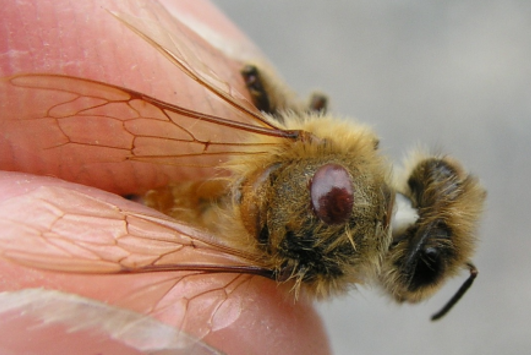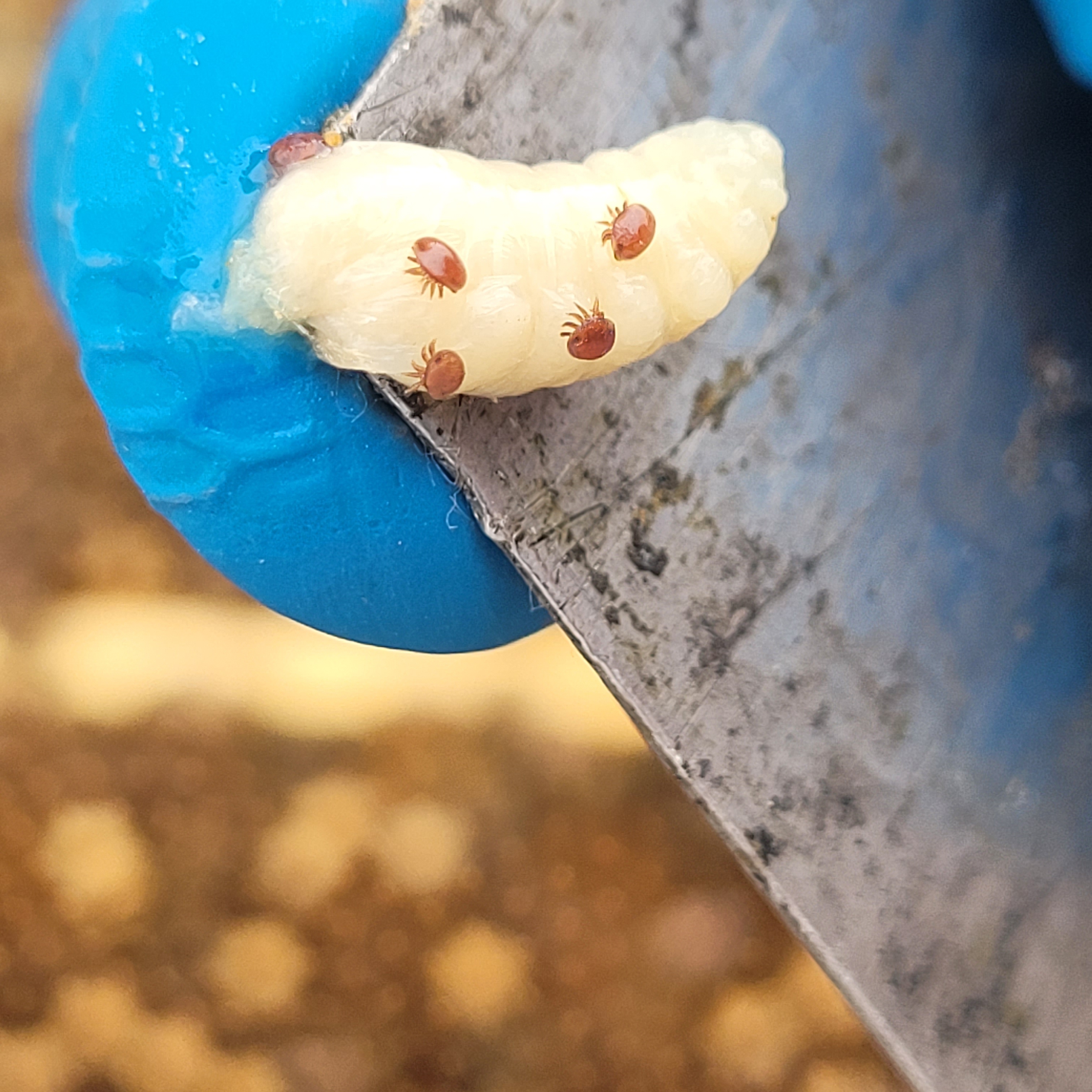
Varroa mite
Varroa mite is the most serious threat to Western Australia’s healthy honey bee populations, honey production and the crops that rely on bees for pollination. Varroa mite are small, oval-shaped reddish-brown mites that parasitise adult honey bees and the brood.
Look and report
Varroa mite is a declared pest in Western Australia.
It is present in parts of eastern Australia but has not been detected in Western Australia (WA). The department has implemented preventative measures including strong border controls to safeguard WA’s bee populations.
Varroa mite (Varroa destructor) is an external parasite of honey bees that feed and reproduce on larvae and pupae, causing malformation and weakening of honey bees as well as transmitting numerous viruses. Heavy varroa infestations can cause colony death.
Varroa mite are small, oval-shaped reddish-brown mites that parasitise adult honey bees and the brood. The mites weaken and kill honey bee colonies and can also transmit honey bee viruses.
Varroa can quickly spread when uninfected bees contact infected bees, hive products, plant material, hives and contaminated beekeeping equipment.
Varroa mite is the most serious threat to our honey and pollination dependent industries.
Impact on bees
Varroa mites weaken bees, reduces their lifespan and increases the spread of viruses. If left untreated, varroa mites will kill a honey bee colony.
Varroa mites are a vector for a number of honey bee viruses including deformed wing virus, sacbrood virus and acute bee paralysis virus. The combination of Varroa mite and deformed wing virus is a leading cause of colony collapse in other countries.
Impact on pollination
Honey bees, managed or feral, are the most effective pollinators of commercial crops due to their physical adaptions, high foraging activity, large colony sizes and specialised pollination techniques.
The introduction of Varroa mite to North America, Europe and New Zealand caused a decline in numbers of feral honey bee managed colonies. In some areas, 95-100 per cent of feral honey bee hives died within three to four years of infestation.
Impact on the economy
If varroa mite establishes in Western Australia, it is likely that 50-60% of beekeepers (mostly hobbyist and part-time commercial) will stop beekeeping due to the difficulty of managing the pest, movement restrictions and rising costs. Larger commercial operators are less likely to be impacted, but their hive numbers could still be reduced.
It will become increasingly difficult for Western Australian honey to maintain its reputation as pure and chemical-free as varroa mite spreads.
Pollination dependent industries who currently receive free pollination from feral and managed hives will rely more on paid pollination services. The cost of these services will likely increase over time as the cost for beekeepers to manage hives increases and resistance to treatments spread.
Varroa mites are oval-shaped, around 1.1 mm long and 1.5 mm wide (slightly larger than a poppy seed). Mites are easily identifiable to the naked eye and are a reddish-brown colour.
Under the Australian Honey Bee Industry Biosecurity Code of Practice, all beekeepers are required to check at least one hive per apiary for external parasites, twice per year, i.e. in autumn and spring. Varroa are very difficult to detect during regular brood inspections, therefore beekeepers are required to use one of the following mite surveillance methods:
- sugar shaking
- alcohol washing
- drone uncapping.
Sugar shaking is non-destructive to bees, while alcohol washing and drone uncapping is fatal to the tested bees. Sugar shake kits can be bought from beekeeping supply stores or made at home.
Varroa mites feed on a honey bee organ call the fat body. The fat body is similar to a human liver in the way it supports the bee’s metabolism and immune system. It is a crucial organ for processing nutrients, detoxifying harmful substances, storing energy and fighting infection.
Heavy varroa infestations result in crippled and crawling bees and a reduction in the honey bee population until the colony eventually collapses resulting in the death of the hive.

Varroa mite spread in 2 main ways:
Within the hive
- moving between bees and brood
- reproducing in bee larvae and pupae.
Between hives and locations
- through bees visiting infected hives
- via swarms and drifting bees
- on beekeeping equipment and clothing
- through moving infected hives.
Legal duty to report
Varroa destructor (Anderson & Trueman, 2000) and Varroa jacobsoni (Oudemans, 1904) are absent from Western Australia and both are quarantine pests. It is a prohibited organism under section 12 of the Biosecurity and Agriculture Management Act 2007.
This means that any person who finds or suspects the presence of Varroa mite must report it to DPIRD.
Reporting is not just a legal obligation; it's crucial for safeguarding your hives and nearby colonies. Early detection gives us the best chance to eradicate pests and diseases. By following best practices and reporting promptly, we can protect Western Australia’s healthy bee populations and stop the spread of harmful pests and diseases.
Make a reportSearch Western Australian Organism List
The Western Australian Organism List (WAOL) provides the status of organisms which have been categorised under the Biosecurity and Agricultural Management Act 2007.
Western Australian Organism List